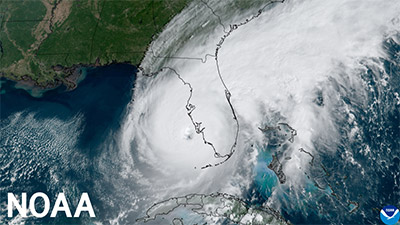
Homeowners likely know the steps to take when preparing for an oncoming storm, but what safe practices should they follow in its aftermath? Any damage to your home and its surrounding infrastructure could prove hazardous, especially if your home is without power, so it’s important to take caution as recovery efforts begin. Read our top-five tips for protecting yourself and your home—even when the sky clears.
When authorities have determined that it’s safe to go outside, conducting a full assessment of your home, yard, and surrounding space is key. Start with a walk around the perimeter of your home, checking for cracks in your foundation, broken windows, and damaged eaves. As you work your way outwards, note any fallen or damaged tree limbs (especially on your roof) as well as live power lines.
Inside your home, check for signs of structural collapse, including cracks in walls and buckling beams or columns. Bubbling behind walls may be an indication of broken or burst pipes, while the smell of rotten eggs suggests a gas leak. Uncovering any of these signs during your assessment is cause to evacuate your home and seek shelter elsewhere until the damage can be addressed safely.
If a severe weather event leads to flooding, it’s important to remember that floodwater is likely polluted. Underwater wildlife, floating tree branches, and debris from damaged houses may all be present. Plus there are invisible pollutants, like harmful bacteria, that could be dangerous if they come in contact with your skin. Roads may also be compromised, so when approaching flooded areas, a good phrase to remember is, "Turn around, don't drown."
If your home has flooded, your home’s electrical wiring and many of your electric appliances may be affected. To avoid any contact with live wires, stay out of your flooded home; even when the water has receded. It may not be safe to search for your belongings. We recommend waiting for clearance from your utility company before entering your home again.
In the wake of a storm, power outages can last for days or even weeks, impacting your supply of tap water and perishable foods. Refrigerated food only lasts up to four hours after the power fails—and only if the refrigerator door is kept shut the entirety of that time. A full freezer can keep food safe for up to 48 hours; that number decreases to 24 hours if the freezer is only half full.
To prevent consumption of potentially spoiled foods, stick to nonperishables like crackers, trail mix, cereal, peanut butter, and canned vegetables or fruit. If your home’s water supply comes from a private or community well, stick to bottled water to stay hydrated during an extended power outage.
Gasoline-powered machinery emits carbon monoxide, a harmful gas that is both odorless and colorless. Appliances like gas grills and gas fireplaces should not be operated without proper ventilation—for grills, this means using them outside, where any outputs can be released into the air safely.
If you’re running a portable generator, be sure to use properly rated extension cords (those that can be used outdoors and have the appropriate electrical load and length). Also, ensure the portable generator is properly vented to avoid carbon monoxide poisoning. Do not place a portable generator in your home or an enclosed space with limited ventilation, like a garage or a screened porch.
Depending on the severity of the storm, power outages may be extended long past the storm itself. Familiarize yourself with your main electrical panel. You may have to turn off the main breaker or reset circuit breakers after an outage. It’s helpful to leave one light on so you know when power is restored to your home. Also, ditch the candles for battery-powered flashlights or lanterns and keep plenty of extra batteries on hand.
Do not connect portable generators directly to the electrical system of your home. Electricity could flow backward into the power lines and endanger lives. Either have a qualified electrician install a manual transfer switch or plug appliances directly into the portable generator.
Want greater resilience to ride out the storm? KOHLER generators deliver quiet, reliable backup power to maintain critical and sophisticated appliances and systems in your home, including lights, heating/cooling systems, sump pumps, computers, and more. Discover some of our most popular generator models and request your free quote to get started.
Whether your need is to power your business to keep on your production schedule or your home to keep your family safe and sound, South Shore Generator has the product diversity to meet all of your generator requirements. We are proud to sell and service generators from 2kW to 2000kW single set units and up to as large as 100MW utilizing Generac's innovative Modular Power Systems (MPS).